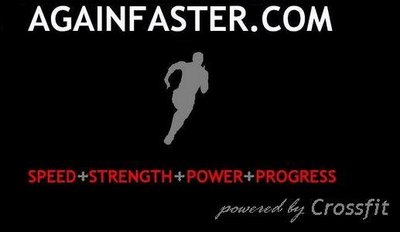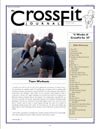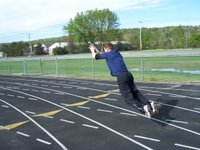Controlled Burn

I get mad as hell. I crank the music, down a few cups of coffee, and attack. About 20 minutes later, I find myself at the bottom of a sweat puddle, thanking the Almighty that my aggressive tendencies led me to Crossfit and not to jail.
The “kill ‘em all” approach to the WOD has its merits. It’s cathartic, you look like a total badass, and everyone stays at least ten feet away from you.
On the downside, you burn out quickly.
A strategic approach to the WOD doesn’t reek of testosterone, but it may leave you better equipped to finish big sets and long workouts.
The other day, we did “Daniel”, a workout named for Army Sgt. 1st Class Daniel Crabtree, who died earlier this month in Al Kut, Iraq.

50 pullups
400 meter sprint
21 thrusters (95# bar)
800 meters
21 thrusters (95# bar)
400 meter sprint
50 pullups
This workout starts and ends with 50 pullups, so busting ass straight out of the gate isn’t a great idea. Instead of doing one set of 25, and then finishing with singles, you’ll want to take a more strategic approach.
Or you could finish dead last. Whatever.
50 pullups, broken down into manageable sets, looks like this:
10-8-7-5-5-5-5-5
You get half the pull-ups out of the way in the first three mini-sets, and pound out the remaining 25 in sets of five. The 5 to 10 second breaks between mini-sets are much more time-effective than two minutes of gasping following a single set of 25. You won’t feel like you’re pushing as hard, but you’ll get done a hell of a lot quicker.
On the first 400, your legs are absolutely fresh. You could probably run this in about a minute. If you do, those thrusters are going to hurt like a motherf*cker.
Quivering thighs don’t support 95# thrusters all that well. Sacrifice 10 seconds here, and you’ll have a little left in the tank for the fun yet to come.
You could probably pound out the first set of thrusters Fran-style, and be back running in a minute and a half. Control yourself, rage-boy.
Three sets of seven will have you done in two minutes. You’re about to run a half mile, and your legs have to hold up for it.
Run the 800 slightly under your mile pace. If you run an 8 minute mile, concentrate on running four 1:45 200s. 7 minute mile? Four 1:30 200s. You get the picture. You’ll still be fast using this technique--faster than your mile pace, anyway.
Now, ladies and gentlemen, it’s time to hit the switch. You’re back from the 800. Time to get amped up.
Blast out the remaining thrusters and sprint the 400 as fast as you can. Try not to be too amused as you blow by everyone else on the sprint.
You should return from the run with a plan for the pull-ups. Break them down just like the first set. If you find yourself struggling hard to complete an early rep, let it go. I see this all the time—somebody pulling with everything they’ve got to complete rep number three of a 50 rep set. Admirable in principal, but stupid in practice.
If you do this, you’re going to absolutely fry your muscles. Instead of the next set being five or ten reps, it’s going to be one or two—if you’re lucky.
If you paced yourself correctly, you should be calling “Time!” when your more excitable brethren start the last set of pull-ups.
Knowing when to get aggie and when to control your workout is a matter of experience, but here are some general guidelines:
If you’re working the same muscle group for two sets in a row—i.e. squats followed by sprinting—be smart about it and control yourself. In the end, small rests won’t add up to the deficit caused by a full-out effort and three minutes of puking.
If you’re doing a workout that lasts less than 10 minutes, or one that constantly alternates functional movement patterns, hammer down. Fran fits both these criteria—you’ll be done quickly, and you’re pushing on one movement and pulling on the other. There’s no time for fatigue to set in.
Cindy has you pulling, pushing, and squatting. Upper body, lower body. You’re switching movement patterns and muscle groups, with 10-15 seconds of rest before you repeat any exercise. Hammer down.
If you’re doing a chipper-style workout, estimate time to completion. If your estimate reaches half an hour, you’re going to need to take a measured approach. If the workout is well programmed, there will be significant interchange between movement patterns and muscle groups, allowing you to fly through. If not, plan your sets.
Controlling your pace doesn’t seem very Crossfit. Regardless, it will let you complete more work in less time, which is what we’re all about at Again Faster. More work in less time equals more power output.
I continue to believe that increasing power output creates top-flight fitness. By completing your exercises without reaching complete neural failure, you can do the next set, and you can get to it with less overall rest. More work in less time!
This is not an invitation to sit around, read a magazine, or check out somebody’s ass. Take five deep breaths, and get back to it. There’s a problem of inertia in Crossfit—the longer you rest, the longer you want to rest. Sometimes it’s better to do burpee number seven immediately after burpee number six, even if you want to puke.
Don’t be that guy standing around for two minutes in the middle of the workout, watching me do squats. You never know if I saved enough reserve power to hurl a dumbbell at your lazy head.
Know when you should go all out, and when you should take a few seconds in between sets. In the end, you’ll just go faster.

I get mad as hell. I crank the music, down a few cups of coffee, and attack. About 20 minutes later, I find myself at the bottom of a sweat puddle, thanking the Almighty that my aggressive tendencies led me to Crossfit and not to jail.
The “kill ‘em all” approach to the WOD has its merits. It’s cathartic, you look like a total badass, and everyone stays at least ten feet away from you.
On the downside, you burn out quickly.
A strategic approach to the WOD doesn’t reek of testosterone, but it may leave you better equipped to finish big sets and long workouts.
The other day, we did “Daniel”, a workout named for Army Sgt. 1st Class Daniel Crabtree, who died earlier this month in Al Kut, Iraq.

50 pullups
400 meter sprint
21 thrusters (95# bar)
800 meters
21 thrusters (95# bar)
400 meter sprint
50 pullups
This workout starts and ends with 50 pullups, so busting ass straight out of the gate isn’t a great idea. Instead of doing one set of 25, and then finishing with singles, you’ll want to take a more strategic approach.
Or you could finish dead last. Whatever.
50 pullups, broken down into manageable sets, looks like this:
10-8-7-5-5-5-5-5
You get half the pull-ups out of the way in the first three mini-sets, and pound out the remaining 25 in sets of five. The 5 to 10 second breaks between mini-sets are much more time-effective than two minutes of gasping following a single set of 25. You won’t feel like you’re pushing as hard, but you’ll get done a hell of a lot quicker.
On the first 400, your legs are absolutely fresh. You could probably run this in about a minute. If you do, those thrusters are going to hurt like a motherf*cker.
Quivering thighs don’t support 95# thrusters all that well. Sacrifice 10 seconds here, and you’ll have a little left in the tank for the fun yet to come.
You could probably pound out the first set of thrusters Fran-style, and be back running in a minute and a half. Control yourself, rage-boy.
Three sets of seven will have you done in two minutes. You’re about to run a half mile, and your legs have to hold up for it.
Run the 800 slightly under your mile pace. If you run an 8 minute mile, concentrate on running four 1:45 200s. 7 minute mile? Four 1:30 200s. You get the picture. You’ll still be fast using this technique--faster than your mile pace, anyway.
Now, ladies and gentlemen, it’s time to hit the switch. You’re back from the 800. Time to get amped up.
Blast out the remaining thrusters and sprint the 400 as fast as you can. Try not to be too amused as you blow by everyone else on the sprint.
You should return from the run with a plan for the pull-ups. Break them down just like the first set. If you find yourself struggling hard to complete an early rep, let it go. I see this all the time—somebody pulling with everything they’ve got to complete rep number three of a 50 rep set. Admirable in principal, but stupid in practice.
If you do this, you’re going to absolutely fry your muscles. Instead of the next set being five or ten reps, it’s going to be one or two—if you’re lucky.
If you paced yourself correctly, you should be calling “Time!” when your more excitable brethren start the last set of pull-ups.
Knowing when to get aggie and when to control your workout is a matter of experience, but here are some general guidelines:
If you’re working the same muscle group for two sets in a row—i.e. squats followed by sprinting—be smart about it and control yourself. In the end, small rests won’t add up to the deficit caused by a full-out effort and three minutes of puking.
If you’re doing a workout that lasts less than 10 minutes, or one that constantly alternates functional movement patterns, hammer down. Fran fits both these criteria—you’ll be done quickly, and you’re pushing on one movement and pulling on the other. There’s no time for fatigue to set in.
Cindy has you pulling, pushing, and squatting. Upper body, lower body. You’re switching movement patterns and muscle groups, with 10-15 seconds of rest before you repeat any exercise. Hammer down.
If you’re doing a chipper-style workout, estimate time to completion. If your estimate reaches half an hour, you’re going to need to take a measured approach. If the workout is well programmed, there will be significant interchange between movement patterns and muscle groups, allowing you to fly through. If not, plan your sets.
Controlling your pace doesn’t seem very Crossfit. Regardless, it will let you complete more work in less time, which is what we’re all about at Again Faster. More work in less time equals more power output.
I continue to believe that increasing power output creates top-flight fitness. By completing your exercises without reaching complete neural failure, you can do the next set, and you can get to it with less overall rest. More work in less time!
This is not an invitation to sit around, read a magazine, or check out somebody’s ass. Take five deep breaths, and get back to it. There’s a problem of inertia in Crossfit—the longer you rest, the longer you want to rest. Sometimes it’s better to do burpee number seven immediately after burpee number six, even if you want to puke.
Don’t be that guy standing around for two minutes in the middle of the workout, watching me do squats. You never know if I saved enough reserve power to hurl a dumbbell at your lazy head.
Know when you should go all out, and when you should take a few seconds in between sets. In the end, you’ll just go faster.




















1 Comments:
Thanks, Josh. The Again Faster stuff should be ready in mid-July, just in time for the sandbag seminar. Oh, I didn't tell you?
We'll be making sandbags and having a heck of a workout. Date TBA. If you're curious about the merchandise, we've got a whole line of men's and women's t-shirts and sweatshirts coming out around July 16th. They're all printed on high-quality American Apparel. Made in the United States, and sweatshop free.
I'll post details about the seminar and the stuff tomorrow.
Post a Comment
<< Home